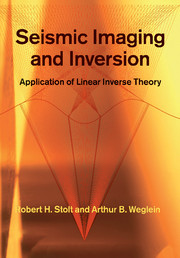Book contents
- Frontmatter
- Contents
- Preface and acknowledgments
- 1 Introduction – modeling, migration, imaging, and inversion
- 2 Basic migration concepts
- 3 Prestack migration
- 4 Migration limitations
- 5 Models for wave propagation and reflection
- 6 Green's functions
- 7 The scattering potential
- 8 Reflectivity
- 9 Synthesizing reflection data
- 10 Frequency–wavenumber migration
- 11 Asymptotic modeling and migration
- 12 Residual asymptotic migration
- 13 Asymptotic data mapping and continuation
- 14 Least-squares asymptotic migration
- Appendix A Conventions and glossary of terms
- Appendix B Coordinates, vectors, and identities
- Appendix C Fourier and Radon transforms
- Appendix D Surface and pointwise reflectivity
- Appendix E Useful filters
- Appendix F The phase integral and the stationary phase approximation
- Appendix G The diffraction integral
- Appendix H Wave-based, ray-based, and reflector-based coordinates
- References
- Index
3 - Prestack migration
Published online by Cambridge University Press: 05 February 2012
- Frontmatter
- Contents
- Preface and acknowledgments
- 1 Introduction – modeling, migration, imaging, and inversion
- 2 Basic migration concepts
- 3 Prestack migration
- 4 Migration limitations
- 5 Models for wave propagation and reflection
- 6 Green's functions
- 7 The scattering potential
- 8 Reflectivity
- 9 Synthesizing reflection data
- 10 Frequency–wavenumber migration
- 11 Asymptotic modeling and migration
- 12 Residual asymptotic migration
- 13 Asymptotic data mapping and continuation
- 14 Least-squares asymptotic migration
- Appendix A Conventions and glossary of terms
- Appendix B Coordinates, vectors, and identities
- Appendix C Fourier and Radon transforms
- Appendix D Surface and pointwise reflectivity
- Appendix E Useful filters
- Appendix F The phase integral and the stationary phase approximation
- Appendix G The diffraction integral
- Appendix H Wave-based, ray-based, and reflector-based coordinates
- References
- Index
Summary
We have formulated basic migration concepts in terms of zero-offset data, even though real data are anything but zero-offset. Fortunately, the ideas are generalizable to finite-offset data.
Prestack migration concepts
Kirchhoff migration is perfectly amenable to prestack data. As long as one can calculate (or tabulate) the traveltimes from source to reflection point to receiver, one can sum into a point all the data that might have come from that point, or, alternatively, broadcast a data point into all the locations from which the data might have come. Kirchhoff methods are happy with restricted data sets such as constant offset, though in some circumstances they may produce artifacts. There are of course issues of amplitude, phase, aliasing, etc., which must be dealt with, some of which are discussed below.
A prestack difference-equation migration algorithm requires extrapolation of both sources and receivers. Given full surface coverage, one could do this by applying the wave equation separately to source and receiver coordinates, downward continuing each in turn, and taking the time-zero doubly downward-continued data to be the migrated image. To image a restricted data set, one must be more devious. For example, a constant-source set can be imaged by downward-continuing the receiver coordinates and cross-correlating at each image point with a forward extrapolation of the source impulse. The imaging principle here is also due to Claerbout (1976): Reflectors exist at points where the arrival of the downgoing wave from the source coincides with the upgoing reflected wave.
- Type
- Chapter
- Information
- Seismic Imaging and InversionApplication of Linear Inverse Theory, pp. 62 - 89Publisher: Cambridge University PressPrint publication year: 2012



